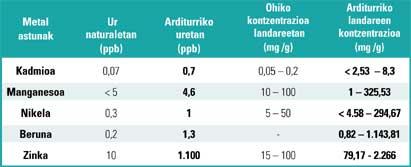The beauty of wastewater
2000/12/01 Elhuyar Zientzia Iturria: Elhuyar aldizkaria
Ironically, one of the types of water pollution can control another, according to the University of Delawar. Most of the sulfide of the channels reaches the wastewater, as some of these sulphides contain some heavy metals such as iron, zinc and copper. More importantly, the remains of heavy metals, such as silver, cadmium and mercury, apparently much more toxic, are also associated with these clusters of metal sulphides. Researchers have found that junctions contain up to six groups of sulphides and form structures that have so far not been observed in nature. Given the stability and durability of these structures that prevent the oxidation and release of the associated metals, it could be thought that they can be very effective for the "collection" of toxic metals to prevent their access to aquatic living beings. Toxicity studies would now be needed to determine whether these chemical elements have biological effects.

Gai honi buruzko eduki gehiago
Elhuyarrek garatutako teknologia





